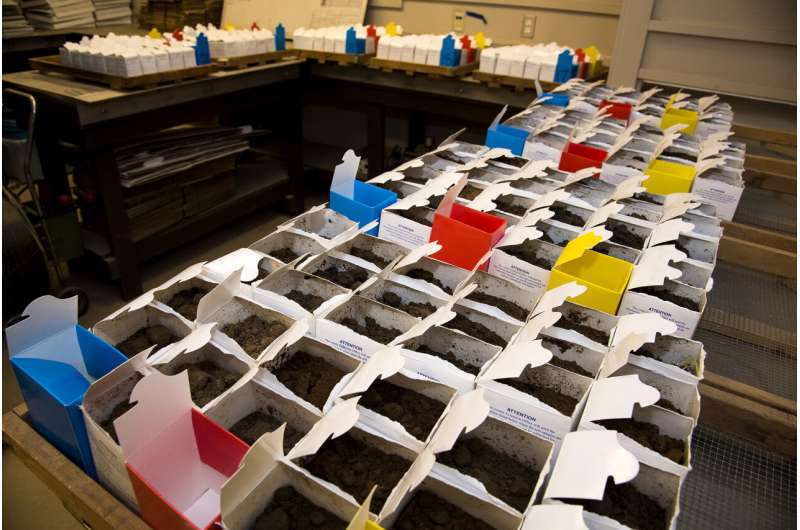This article has been reviewed according to Science X's editorial process and policies. Editors have highlighted the following attributes while ensuring the content's credibility:
fact-checked
trusted source
proofread
Soil testing time saver predicts key soil health characteristics

Farmers in a time crunch have a new, speedier option for analyzing the texture and organic matter content of the soil on their fields.
Gerson Drescher, assistant professor of soil fertility for the Arkansas Agricultural Experiment Station, has led a study to create prediction models for these key soil health indicators based on standard tests already being used to analyze soil samples.
"We want to provide people with the maximal amount of information that they can get from samples they are already submitting without the additional cost and time of analysis," Drescher said.
The newly developed prediction model can help add information about the soil's properties, which can guide fertilization, irrigation, and herbicide decisions, Drescher added. Standard soil testing evaluates plant-available nutrient content and soil pH. However, these properties are also affected by soil texture and organic matter in the soil, which require additional expensive and time-consuming tests.
"The traditional methods used for both soil texture analysis and organic matter determination are relatively time-consuming, and generally, producers are interested in a quick turnaround when they submit a sample so they can make their nutrient management decisions and make plans for the amount of fertilizer they need to apply," Drescher said.
The research article titled "Soil texture and organic matter prediction using Mehlich-3 extractable nutrients" is published in Agrosystems, Geosciences & Environment. Co-authors include Trent Roberts, professor and interim department head of crop, soil, and environmental sciences; Nathan Slaton, associate vice president for agriculture and assistant director of the Arkansas Agricultural Experiment Station; and Alden D. Smartt, program associate in the crop, soil, and environmental sciences department.
The models are accurate for predicting the most common soils used in crop production in Arkansas. However, the models are less accurate for sandy soils and soils with very high organic matter, Drescher said. The state's common agricultural soils are fine and medium categories, which include silt loams and silty clays.
The experiment station is the research arm of the University of Arkansas System Division of Agriculture.
What's in the soil?
The time a soil test takes depends on the information requested, Drescher said. Each additional test on top of the routine soil analyses can add days or weeks to the total testing time. Drescher's prediction model for organic matter and soil texture cuts those additional tests and can reduce turnaround time by at least half.
Soil samples sent to a lab for analysis are dried, ground and sieved for uniformity to ensure the precision and accuracy of the analysis. In Arkansas, the experiment station's Marianna Soil Test Laboratory provides routine soil testing services, which are free for Arkansas residents.
Routine soil testing calls for measurement of soil pH and the Mehlich-3 soil analysis, which extracts and identifies the available nutrients in soil samples.
The two properties predicted by Drescher's model—soil organic matter and soil texture—require more extensive tests, Drescher said. Testing for soil organic matter is determined by a method known as "loss on ignition," which requires weighing samples, subjecting them to high temperatures to combust the organic matter, and reweighing the sample to measure weight loss.
Soil texture is measured using a device called a hydrometer, which determines soil particle sizes, Drescher said. Understanding soil texture is an important aspect of crop production because it dictates the ability of the soil to hold nutrients, the rates of herbicide or fertilizer application, irrigation scheduling and soil sampling protocols.
These tests help producers understand the health of their soil and guide fertilizer applications and crop management decisions, Drescher said.
Better than a map
Maps, such as the Web Soil Survey offered by the U.S. Department of Agriculture's Natural Resources Conservation Service, can be used to provide information on soil type in different areas, but the resolution of the map might not indicate changes in soil texture in a small amount of space within a field, Drescher said. The new prediction model is more precise than a map because it uses field-specific information.
The Marianna Soil Test Lab already provided soil texture predictions, but this new research fine-tuned the model to make the estimation more accurate, Drescher said.
The Marianna Soil Test Lab analyzes about 200,000 soil samples every year. Routine soil tests for nutrients and pH are free for Arkansas residents through the support of Fertilizer Tonnage Fees. Non-routine tests of soil texture or organic matter analysis, however, have a fee and take additional time for analysis.
The prediction models
Drescher used Mehlich-3 nutrient and soil pH data from soil samples submitted to the Marianna Soil Test Lab to calibrate and validate the prediction models.
For the clay and sand prediction models, he used data from 409 soil samples, representing different production systems and soils throughout Arkansas. About half were from row crop fields and the other half from forage systems.
When developing the model for soil organic matter, he used data from 604 samples from row crop fields and 415 samples from forage production areas.
After the calibration, Drescher validated the models by using 103 different soil samples from row crop, forage, vegetable, fruit, turfgrass and ornamental production areas.
Over time, the models can be evaluated for accuracy and optimized with new soil samples to improve soil texture and organic matter prediction. Drescher said the models could be used in areas outside of Arkansas if they have similar soils.
Drescher said he appreciated the work performed by the Marianna Soil Test Laboratory personnel who assisted with soil analysis and provided the data for the models' calibration.
More information: Gerson L. Drescher et al, Soil texture and organic matter prediction using Mehlich‐3 extractable nutrients, Agrosystems, Geosciences & Environment (2024). DOI: 10.1002/agg2.20461
Provided by University of Arkansas





















